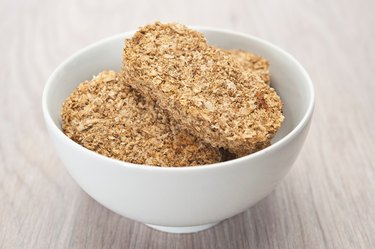
The Weetabix Diet, also known as the Right Weight Fiber Diet, is a 1,200-calorie meal plan that incorporates Weetabix breakfast products. Along with Weetabix foods, you'll be eating a variety of fruits, vegetables, proteins and minimal fats as part of the diet.
A staple in the United Kingdom since the 1930s, Weetabix is known primarily for its original-variety breakfast biscuits. These rectangular-shaped biscuits are made with whole grains and malted barley extract, among other ingredients.
Video of the Day
Video of the Day
Weigh the benefits of Weetabix nutrition against the potential drawbacks before getting started with this meal plan. Also, check with your doctor to be sure it's the right choice for you.
Read more: Calorie Restriction Diet Meal Plans
Weetabix Diet Basics
The Weetabix Diet consists of a 250-calorie breakfast incorporating Weetabix nutrition, plus a light meal and a main meal chosen from a list of approved foods. Each two-biscuit serving of the original Weetabix biscuits contains 130 calories, according to the U.S. Weetabix website.
In addition to Weetabix nutrition, the diet focuses on eating a variety of balanced meals with lean proteins, fruits, vegetables, whole grains and low-fat dairy, according to Weetabix Food Company. It also emphasizes upping your fluid intake due to the increased amount of fiber in the diet.
The following guidelines will get you started with the Weetabix diet. Be sure to carefully portion out your food and stay within 1,200 calories a day.
Daily allowances:
- 1/2 pint skim milk for drinks, cereal and cooking
- 1/2 ounce low-fat spread
- Tea, coffee and low-calorie or sugar-free soft drinks
- Mineral or tap water
Sample Breakfast:
- Two Weetabix or Weetabix Organic biscuits or their equivalent, such as Oatibix or Weetabix Minis
- Milk from the daily allowance
- 4 ounces unsweetened fruit juice
- 1 slice wholemeal toast with low-fat spread from the daily allowance
Sample Light Meal:
- Two slices wholemeal bread with mustard, lettuce and 2 ounces lean ham
- Medium apple
- Unsweetened, low-fat yogurt
Sample Main Meal:
- 4 ounce cod kabobs with onion, pepper and tomato
- 4 ounce cooked brown rice
- Sliced cucumbers
- Sliced peaches with unsweetened, low-fat yogurt
Read more: 19 High-Fiber Foods — Some May Surprise You!
Benefits of the Weetabix Diet
The benefits of the Weetabix Diet lie primarily in its promotion of a balanced approach to nutrition. Each meal incorporates items from the different macronutrient groups, with carbs, protein and fat included in every meal.
The inclusion of plenty of fruits and vegetables in the Weetabix Diet may help you to feel satiated. These foods are low-energy-dense, meaning they have a high amount of nutrients without a lot of calories.
Indeed, research published in July 2014 in the International Journal of Obesity supports eating a diet of low-energy-dense foods for healthy weight management.
The 2015-2020 Dietary Guidelines for Americans similarly encourage eating a variety of foods from different food groups, including fruits, vegetables, lean proteins, low-fat dairy and whole grains. The Dietary Guidelines also advise eating within a recommended macronutrient profile — around 45 to 65 percent carbs, 25 to 35 percent fat and 10 to 30 percent protein for your daily calories.
Understand the Drawbacks
At the same time, the Dietary Guidelines also recommend eating more calories than the Weetabix Diet suggests — around 1,600 to 2,400 calories a day for adult women and 2,000 to 3,000 for adult men. For some people, 1,200 calories a day might not be enough, especially if you're exercising.
Research published in Perspectives on Psychological Science in September 2017 notes that cutting calories may help you lose weight initially, but it can also result in weight regain later.
According to the research, severely restricting calories may reduce your metabolic rate, causing you to burn fewer calories at rest. Your appetite may also increase and the weight lost can come right back, and then some.
Note that the Weetabix Diet encourages 20 to 30 minutes of exercise, three to five times a week. It does not specify how vigorous the exercise should be, nor does it specifically address strength training.
In contrast, the Physical Activity Guidelines for Americans recommend getting at least 150 minutes of moderate-intensity activity a week, plus two days of strength training for all major muscle groups.
Whether you follow the Weetabix guidelines for exercise or the Physical Activity Guidelines, know that you may need to eat more than 1,200 calories to keep your energy levels up and avoid any weight regain.
- Weetabix: "The Right Weight Fibre Diet"
- Office of Disease Prevention and Health Promotion: 2015-2020 Dietary Guidelines for Americans: "Key Elements of Healthy Eating Patterns"
- Office of Disease Prevention and Health Promotion: 2015-2020 Dietary Guidelines for Americans: "Appendix 7. Nutritional Goals for Age-Sex Groups Based on Dietary Reference Intakes and Dietary Guidelines Recommendations"
- Office of Disease Prevention and Health Promotion: 2015-2020 Dietary Guidelines for Americans: "Appendix 2. Estimated Calorie Needs per Day, by Age, Sex, and Physical Activity Level"
- Weetabix USA: "Weetabix"
- U.S. Department of Health & Human Services: "Physical Activity Guidelines for Americans"
- National Center for Biotechnology Information, U.S. National Library of Medicine: International Journal of Obesity: "What Is the Role of Portion Control in Weight Management?"
- National Center for Biotechnology Information, U.S. National Library of Medicine: Perspectives on Psychological Science: "Reducing Calorie Intake May Not Help You Lose Body Weight"